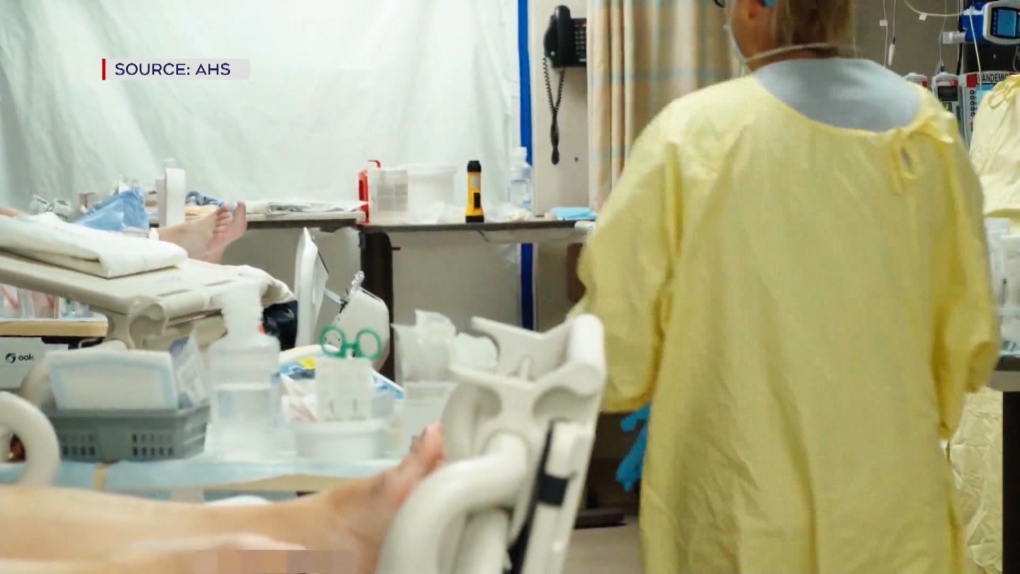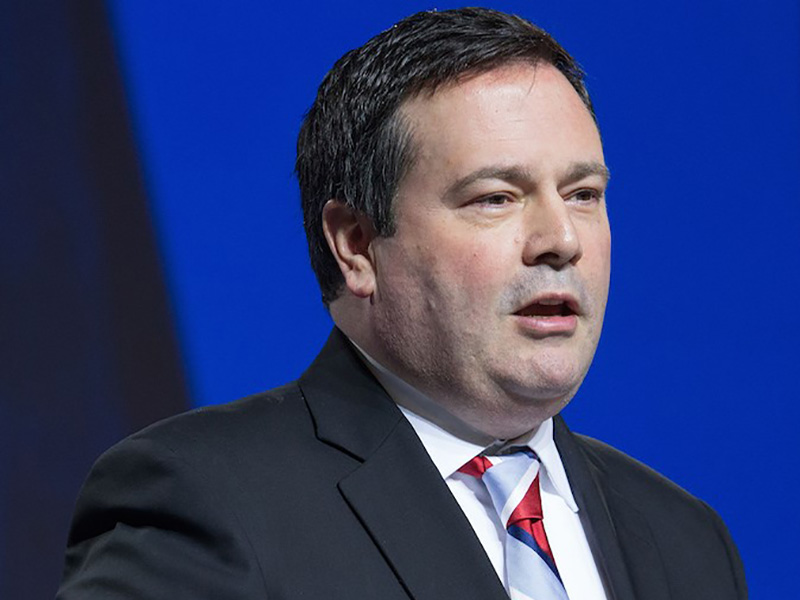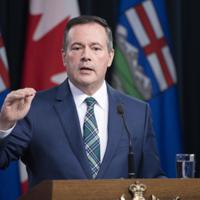Author of the article: Anna Junker
Publishing date: Oct 05, 2021 •

Edmonton Public Schools is calling on the province to implement firebreak COVID-19 public health measures that would see the closure of all schools in the province.
The recommendation, brought forward Tuesday, asks for all schools to move to online classes for a minimum of two weeks
Board chair Trisha Estabrooks said the division does not have the jurisdiction to close schools themselves, and she agonized over whether to vote for the firebreak recommendation.
“I feel like we’re letting families and kids down. I’ve spoken to families and parents, we’re lifelines, schools are literally lifelines for these families,” she said.
“Families continue to suffer because of a lack of information and clarity, and I just keep saying it didn’t have to be this way. Kids are suffering when they have their pediatric cancer surgeries canceled, for crying out loud. If that’s not an indicator of a crisis in our province, I don’t know what else is.”
If the province were to close schools, the board is also asking for notice in advance of any closure as well as financial support for families. The recommendation is one of four passed by trustees during a special board meeting on Tuesday.
Other trustees also had strong words about having to be in the position to advocate for the Alberta government to take action to address the fourth wave of COVID-19.
Trustee Nathan Ip said sometimes he feels like he is living in the Twilight Zone, having to make decisions like these during a public health crisis.
“I do feel compelled to take a moment to call out our provincial government, because it is a spectacular abdication of responsibility and failure of leadership,” he said.
“There is really no two ways about it. School boards have been left in the dark for weeks and months.”
Speaking after the board meeting, Estabrooks said she believes the division wouldn’t have had to call for a firebreak if the province had reinstated notification of positive cases, contact tracing and isolation when the school year began.
“I highly doubt we would be in this situation, and so it didn’t have to be this way and this is an absolute last resort,” she said.
“I’m a parent myself, I speak to many parents on a daily basis, no one wants to be in this situation, but at what point do we recognize that this is just not sustainable?”
She noted the division has been very clear in their ask of the province to share COVID-19 information.
“These are the measures that worked last year,” she said. “I continue to be frustrated and a little baffled, quite frankly, why we’re not seeing those measures put in place.”
The second recommendation trustees passed was to continue to advocate for testing, tracing and isolating of COVID-19 cases in schools and resume notification by Alberta Health Services of positive cases.
However, during an update on COVID-19 Tuesday afternoon Education Minister Adriana LaGrange said the province is reinstating contact tracing.
In the interim, beginning Oct. 12, school authorities will determine close contacts of individuals who were infectious while attending school, and they will notify families of those close contacts. By mid-November, Alberta Health Services (AHS) will take over identification of close contacts.
“School authorities will help this AHS team to identify close contacts and will focus on school-based exposures only, such as identifying classroom contacts and close contacts through participation in school sports or extracurricular activities,” she said.
“Contact notification will not extend to positive cases, community activities or out of school contacts.”
When asked about the call for a two-week shutdown and why it took so long for the government to reinstate contact tracing, LaGrange said they have been monitoring the situation closely, added other measures to keep students safe, and “will continue to do what is required to keep our students and our staff safe.”
Edmonton Public is also calling for HEPA units to be used in classrooms for increased ventilation and air quality, and to call for the province to provide rapid COVID-19 tests to families that can be used at home.
However, the province will seek six million rapid antigen tests to help parents administer two tests per week to unvaccinated children, beginning in high-priority areas such as schools that are experiencing an outbreak and under-vaccinated areas.
“Every student and staff member at these schools will be able to access tests for free,” she said.
As of Monday, there were 699 self-reported COVID-19 cases across 175 schools since school began in September, Supt. Darrel Robertson said.
About 67 per cent of those are in kindergarten to Grade 6, 11 per cent are in grades 7 to 9 and 13 per cent are in grades 10 to 12.
There are also 55 cases of COVID-19 among staff.
Meanwhile, Edmonton Catholic Schools announced Tuesday it would be mandating vaccines for all employees. They have until Oct. 25 to be fully vaccinated, unless they require an accommodation under the Alberta Human Rights Act or participate in a regular, rapid COVID-19 testing program.
Others who are in direct contact with students and/or employees must also be fully vaccinated in order to enter a division property, including contractors and volunteers.
With files from Ashley Joannou
Alberta to resume contact tracing in schools, provide rapid testing kits to families
Some critics say return of contact tracing
comes too late
The Alberta government is bringing back contact tracing in schools and plans to provide rapid testing kits to help parents in outbreak areas test their children twice a week at home.
Education Minister Adriana LaGrange announced Tuesday that schools will start notifying close contacts of students who were infectious at school.
The shift comes with the province in the midst of a deadly fourth wave of COVID-19 that has overwhelmed the province's hospitals and ICUs and forced the government to accept medical help from the Canadian Armed Forces, the Red Cross and other provinces.
Alberta Health Services had stopped notifying schools of positive test results so districts were relying on parents to tell them if their children fall ill.
Some school boards and other advocacy groups have been calling for contact tracing and other measures since the beginning of the school year. Now, some critics say Tuesday's announcement comes too late.
At a news conference Tuesday, LaGrange defended her government's COVID-19 approach for schools.
"We started the year with very strong protocols," she said, listing the masking and cohorting measures already in place.
"We will continue to monitor very, very closely, and if additional measures are required we will absolutely do that."
Public list of schools on outbreak
On Wednesday, Alberta Health will start publicly listing schools that have more than two students who were infectious while in school.
Alerts will be issued if a school has two to four cases, or five to nine cases. If a school has 10 or more cases, an outbreak will be declared. This is a shift from the province's previous requirement that 10 per cent of a school population be infected with COVID-19 before an outbreak would be declared.
Alberta Health Services will investigate all outbreaks at schools within a two-week period.
Contact tracing
Beginning Oct. 12, parents will be informed if their child may have been exposed to COVID-19 at school. Initially, school authorities will handle contact tracing and notification using data supplied by Alberta Health Services.
Alberta Health Services will take over contact tracing in schools by the middle of November. At that point, an online map will be available where parents will be able to view alerts and outbreaks at schools.
Students in Kindergarten to Grade 6 will move to online learning from home if there are three or more infectious cases in a class in a five-day period. Families of students in a class that gets sent home will be asked to avoid public places, monitor for symptoms, and get tested if a child starts showing symptoms. The families will not be required to otherwise quarantine.
Rapid tests for Kindergarten to Grade 6
Officials also announced a targeted rapid testing program for Kindergarten to Grade 6 schools as vaccines aren't yet available to students in that age group.
The province will start handing out tests in late October at schools that are on outbreak status. Tests will be distributed to staff and parents. The rapid tests are voluntary, and are to be done at home as a screening tool for students who are asymptomatic.
The province is also encouraging school districts to enact mandatory vaccination policies for staff.
LaGrange says the province can't enact a similar policy for students because they cannot be denied access to schools.
Return of contact tracing welcomed
Calgary Board of Education Superintendent Christopher Usih said he welcomes news that contact tracing will return.
"We've had situations where families have expressed concerns around the self-notification option that was in place because it was very difficult to establish the veracity of that information and even to know whether or not we're getting full compliance around that piece," Usih said.
He was also pleased to see the change in classifying an outbreak at 10 students rather than 10 per cent of students.
No 'firebreak'
Earlier on Tuesday, Edmonton Public School Board trustees passed a motion calling on the province to reinstate case notification, contact tracing and isolation of close contacts in schools, to enact provincial ventilation standards and for Alberta Education to purchase specialized air filters for classrooms that meet standards set by experts.
WATCH | "It didn't have to be this way," says board chair Trisha Estabrooks
Edmonton Public Schools board chair Trisha Estabrooks says the provincial government should have prioritized in-person learning from the planning stages. 5:08
Trustees also called for a "firebreak" — a two-week minimum closure of all Alberta schools in an effort to prevent further spread of COVID-19. Districts are not able to close schools without the permission of Alberta Education.
"On the one hand I'm glad they're putting these measures in place, on the other hand I fear that it is too late," said Edmonton Public School Board trustee Shelagh Dunn on Tuesday evening.
Dunn said Tuesday that none of the trustees want to see schools closed and that they know the disruption in learning wouldn't be good for students. But she said it feels like the time for last resort measures have arrived.
"However, there's been such a lack of provincial leadership in this situation, and the case numbers are so great and the impact on our hospitals is frightening to watch."
Dunn's own son got COVID-19 during an outbreak that saw nearly a quarter of the students in his school test positive.
"It really threw our community into chaos. There was no contact tracing by AHS, there was no notification to the school about cases other than those that parents were calling in themselves. And it did happen really quickly," she said.
Reacting to LaGrange's announcement, NDP education critic Sarah Hoffman called the measures "too little, too late," and said the government has dumped the burden of contact tracing onto school staff.
But Hoffman stopped short of calling for moving classes online, and said she thinks schools should be the last place to be shut down. She said that's why she has called on the province to ask the Canadian Armed Forces for personnel to help with contact tracing.
"To say 'we're going to take another six weeks to set up a contact tracing system' I don't think is good enough. I think if they do see the urgency here, if the UCP sees the urgency, they need to call in the help."
With files from Paige Parsons and Lucie Edwardson
'These measures were needed a month ago, and the urgency was there to act long before now,' said Medeana Moussa, spokeswoman for the Support Our Students advocacy group
Author of the article :Eva Ferguson
Publishing date:Oct 05, 2021 •

Weeks after the start of the school year and long after school boards and parents pleaded for help, the UCP government is finally vowing to support schools with phased-in contact tracing and rapid tests as COVID cases in kids continue to soar.
But questions remain as to whether the help is too little too late, and how much support will arrive exactly when, with promises of “after Thanksgiving,” “late October,” and “mid-November.”
Education Minister Adriana LaGrange announced phased-in support from Alberta Health Services to help schools with contact tracing, identifying positive cases and notifying close contacts.
“This fourth wave has made things challenging, especially for families of children not yet eligible for vaccine,” LaGrange said.
“We’ve always committed to monitoring the pandemic and making changes to ensure in-person learning can continue safely.”
But phased-in contact tracing won’t begin until after the Thanksgiving long weekend, and will still require help from school authorities until the middle of next month.
Dr. Deena Hinshaw, chief medical officer of health, said it will take at least four to six weeks to recruit and hire the contact tracers required to do the work.
“It’s not that easy to just flick a switch,” LaGrange said, saying AHS won’t fully take over contact tracing until mid-November.
As well, close contacts will only be required to isolate for 10 days if there are three or more cases in a classroom. That protocol still differs from last year when an entire classroom would have to isolate when just one case was identified.
Parents have been demanding full reinstatement of AHS reporting, contact tracing and isolating since early August, when Support Our Students issued a news release asking for more robust safety protocols.
And on Sept. 17, the Calgary Board of Education sent a letter to LaGrange demanding the return of contact tracing and more supports from AHS.
“These measures were needed a month ago, and the urgency was there to act long before now,” said Medeana Moussa, spokeswoman for the Support Our Students advocacy group.
“The UCP government’s refusal to act sooner has all but caused this fourth wave and the terrible health crisis Alberta now finds itself in.”
As COVID cases surge and hospitals struggle with capacity, provincial data shows Alberta kids aged 5 to 11 years of age are hitting a seven-day average of 68 cases per 100,000, the highest for that demographic since the start of the pandemic.
The next highest peak occurred during the third wave, in May, when kids aged 5 to 11 years hit a seven-day average of 54 cases per 100,000.

The province says it will also ramp up rapid testing in schools, but that support won’t come until “late October” when tests will be provided to parents and staff connected to schools that are in outbreak status with 10 or more cases of COVID-19.
The AHS will now be reporting COVID case numbers in schools across Alberta on its website.
The UCP government is also encouraging school authorities to develop policies that require proof of vaccination or a negative COVID-19 test for teachers, staff and anyone who enters a school.
The call comes days after Premier Jason Kenney said only school districts can issue vaccine mandates as employers of school staff, not the province.
The CBE announced Tuesday that all employees and CBE partners must be fully vaccinated against COVID-19 by Dec. 17, including contracted service providers, tenants and all volunteers.
The board is providing more than two months as a transition period to give individuals time to declare their vaccine status and comply.
Meanwhile, the Calgary Catholic School District is expected to discuss similar legislation for its employees at a board meeting Wednesday.
Still, parents continue to be fearful of taking kids to school, wondering whether even if they aren’t sick, they’re spreading the virus to family members at a time when the highly contagious Delta variant is infecting both vaccinated and unvaccinated people.
Moussa added parents are frustrated with the lack of leadership and slow movement on COVID and rising cases in schools by the UCP government.
“The province could have easily implemented these protocols to ensure that schools remain safe,” Moussa said.
“Instead, they have allowed the Delta variant to rip through schools, download responsibility, point fingers at school districts and continue to be a government that refuses to govern.”
Meanwhile, 10 vaccination clinics at Calgary schools are among 300-plus clinics that have been cancelled across the province due to a lack of consent.
As of Sept. 28, approximately 221 in-school COVID-19 immunization clinics had been completed in Alberta, 128 of those in Calgary, and 438 were still planned.
In-school clinics are scheduled to continue until Oct. 15.
The UCP clings to its own myths until there’s no choice but to act, too late every time
Author of the article: Don Braid • Calgary Herald
Publishing date: Oct 05, 2021 •

Article content
While the Kenney government was working up its latest COVID-19 plan Monday and Tuesday, 26 more people died and a lot of children got sick.
Remember when the government said the dying was ending? Remember when they said young kids weren’t at much risk?
At this moment, children from five to 11 years old make up one-quarter of reported cases. Schools will now go back to contact tracing, rebranded as “contact notification.”
But teachers will do some of it themselves because the government took down the school tracing system, despite begging from educators everywhere to keep it running.
The policy shift in the “greatest summer,” when the UCP went into pandemic denial, caused COVID chaos in the school systems.
Undeniably, it also caused more kids to catch the virus, which they will now be spreading outside the schools.
This is what one school board east of Edmonton told teachers only weeks ago: “At the direction of the chief medical officer of health, Alberta Health Services will no longer notify close contacts of potential COVID-19 exposures including close contacts in school.”
And then — if you can believe this — the notice said: “Due to privacy law, we cannot ask or disclose if students and staff are exposed or positive.”
Teachers were actively prohibited from telling any child, or parent, if there were sick kids in the classroom.
The teacher also could not be told if any child was sick. The kids couldn’t tell each other.
One teacher said: “I don’t even get to know if any kids in my class have COVID. Ridiculous!”
That was a policy petri dish for COVID-19.
Now, information sharing is back, the latest of the government’s wild gyrations during this crisis.
NDP education critic Sarah Hoffman was even more fierce than usual when she said Tuesday: “The COVID situation in Alberta schools has spiralled out of control due to the gross negligence of (Education Minister) Adriana LaGrange and every one of the UCP MLAs who remained silent while the virus tore through the schools in their communities.
“For the first time today, the premier spoke about the rapid spread of COVID among children.
“For months, we have known about the spread of COVID ramping up among school-aged children but the UCP has always dismissed the risk to young Albertans.”
In May 2020, when infections were falling, Premier Jason Kenney told the legislature: “What we are learning is that younger people, although not completely immune, have a rate of mortality related to COVID that is no higher than their general mortality rate from other illnesses.”
By saying that kids are “not completely immune,” the premier suggested they are partly immune, which is clearly not true.

The virus has evolved, obviously. What’s shocking is how the government doesn’t evolve along with it. The UCP clings to its own myths until there’s no choice but to act, too late every time.
Sun columnist Rick Bell asked Kenney on Tuesday how he could regain trust. The premier didn’t even pretend to respond.
But it’s an important question, because a government that isn’t trusted is much less likely to be obeyed.
If the new measures announced Tuesday are simply scorned and flouted, Thanksgiving 2021 will give the virus an even bigger boost than it did last year.
They’re asking unvaccinated people not to gather indoors and limiting the vaccinated to 10 people over 12 years old, from only two families. The outdoor gathering limit has been dropped from 200 people to 20.
The indoor rule is especially hard for families longing to gather.
And yet, to paraphrase the risqué old British saying, people should close their eyes and think of Alberta. Defying the government will only make everything worse.
Don Braid’s column appears regularly in the Herald
Twitter: @DonBraid
Facebook: Don Braid Politics
BY SAIF KAISAR AND HANA MAE NASSAR
Posted Oct 5, 2021

FILE (CityNews)
SUMMARY

Alberta appears to be changing course on contact tracing in schools

Sources confirm to 660 NEWS the province will be bringing contact tracing back to classrooms

Contact tracing in schools ended when other COVID-19 measures were scaled back over the summer
CALGARY (660 NEWS) – Contact tracing will be coming back to Alberta schools, government sources have confirmed to 660 NEWS.
The province is expected to make the official announcement at 3:30 p.m. on Tuesday.
Premier Jason Kenney will be joined by Health Minister Jason Copping, Education Minister Adriana LaGrange, Chief Medical Officer of Health Dr. Deena Hinshaw, and Alberta Health Services President and CEO Dr. Verna Yiu for the announcement.
The return of contact tracing comes as Alberta continues to struggle with increasing COVID-19 case loads.
Contact tracing had been taking place in schools last semester. However, as part of changes when restrictions were loosened this summer, those measures were scaled back in classrooms.
Many had been calling for the province to reinstate contact tracing, as well as other measures, as more students got sick.
Though the situation in Alberta continues to be dire, the province reported on Monday a slight drop in the number of critically ill COVID-19 patients in hospital.
On Monday, an infectious diseases expert urged people to continue to take every precaution possible, saying COVID-19 could still be something we are dealing with for decades to come.
Experts continue to urge people to get vaccinated if they can, to protect those around them, including children who are not eligible for a shot yet.
Contact tracing coming back to Alberta schools
BY ANGELA STEWART AND TOM ROSS
Posted Oct 5, 2021
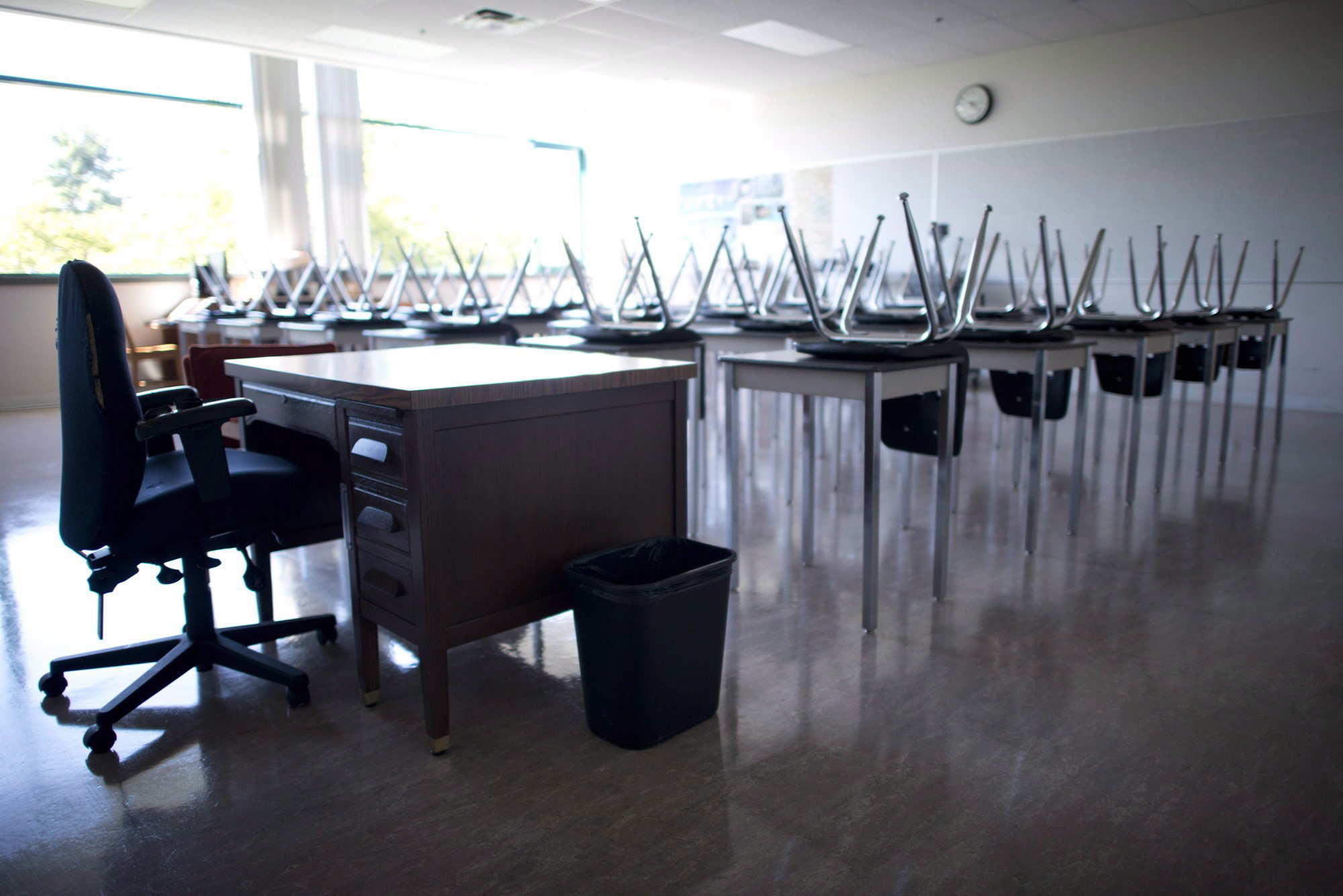
An empty teacher's desk is seen at the front of a empty classroom at McGee Secondary school in Vancouver on September 5, 2014. Alberta is planning to reopen schools in the province this fall even as cases of COVID-19 in the province continue to grow.
CALGARY (660 NEWS) – After months of pressure coming from school advocacy groups and parents, the province has decided to reinstate contact tracing in schools across Alberta.
“We have always maintained that our first priority is the safety and security of our students and staff and that will always be our number one priority,” said Adriana LaGrange, Education Minister.
“We started the year with very strong protocols. [In] mid-September, when there was a state of emergency, we added additional masking for grades four and up and all staff. We have also implemented cohorting for K-6 schools.”
Parents will soon be able to have a better idea if their child has been exposed to a positive COVID-19 case in school, but it won’t be taking effect right away.
“It’s not that easy to just flick a switch and start contract tracing again. We are going to have contact notification starting next week,” said LaGrange.
The province expects tracing will be back up and running in about four to six weeks.
More staff will need to be hired before complete tracing actives can resume.
Rapid testing will also be offered to start with K-6 classes in schools that experience outbreaks.
“We will continue to monitor very, very closely and if additional measures are required, we will absolutely do that.”
“Right now, we have nine schools that have transitioned to online learning for operational reasons,” added LaGrange.
The free kits will need to be picked up at the schools.
New gathering restrictions in place, 663 new COVID-19 cases
BY ANGELA STEWART
Posted Oct 5, 2021

This undated electron microscope image made available by the U.S. National Institutes of Health in February 2020 shows the Novel Coronavirus SARS-CoV-2, yellow, emerging from the surface of cells, blue/pink, cultured in the lab. Also known as 2019-nCoV, the virus causes COVID-19. Ontario is reporting three new cases of the novel coronavirus today, bringing the total in the province to 18.
CALGARY (660 NEWS) – The province is announcing new gathering restrictions in time for Thanksgiving.
Starting Monday, those who are unvaccinated will no longer be able to gather indoors. However, vaccinated people can have an indoor gathering with up to 10 people.
When it comes to outdoor gatherings, those restrictions have been dropped from 200 guests to 20.
Albertans are being urged to follow the rules this Thanksgiving weekend.
“Our hospitals and front-line teams do not have the capacity to handle another significant spike in cases,” said Dr. Verna Yiu Tuesday afternoon.
When it comes to new COVID-19 cases in the province, 663 new cases have been confirmed.
In the last 24 hours, 8,018 tests were completed.
Sadly, 26 more people have died from COVID-19 related complications.
There are 1,094 people in the hospital — and of those, 252 are in the ICU.
Alberta has 19,456 active cases province-wide.
COVID-19 vaccines mandatory for CBE employees
BY 660 NEWS STAFF
Posted Oct 5, 2021
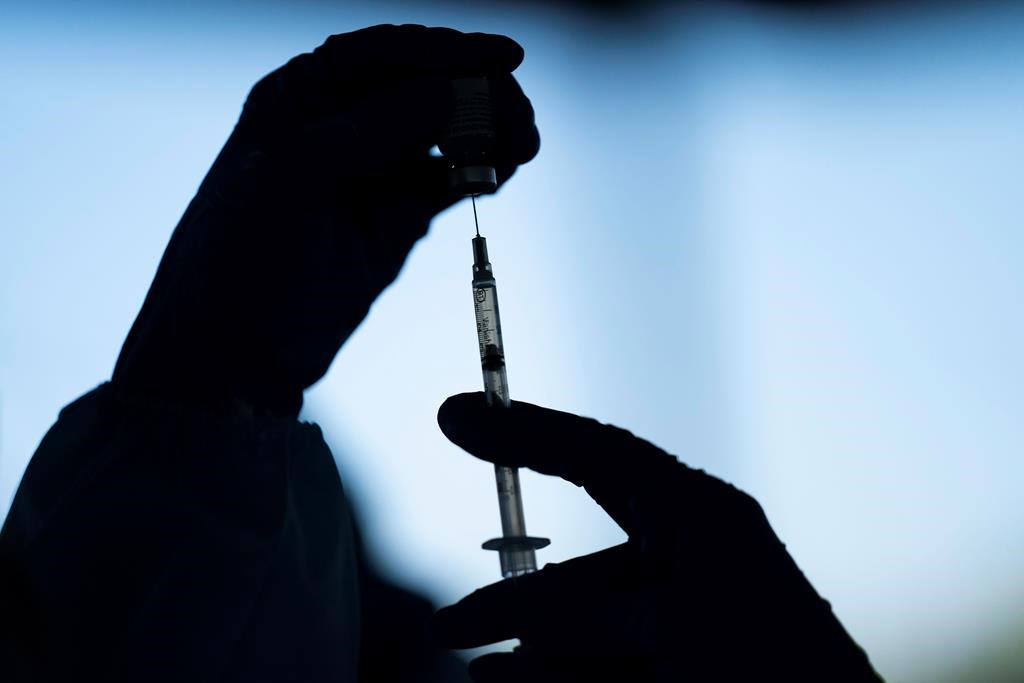
FILE - In this Jan. 21, 2021 file photo a medical staff member prepares the Pfizer COVID-19 vaccine at Tudor Ranch in Mecca, Calif. With vaccination against COVID-19 in full swing, social platforms like Facebook, Instagram and Twitter say they’ve stepped up their fight against misinformation that aims to undermine trust in the vaccines.
CALGARY (660 NEWS) – The Calgary Board of Education (CBE) is mandating COVID-19 vaccines for all its employees, volunteers, and other CBE partners.
The news comes as the Edmonton School Board made it mandatory that all employees be vaccinated against the virus.
READ MORE: Alberta teachers support mandatory vaccination policy for educational staff
The mandate will not take effect until Dec. 17.
RELATED: Contact tracing coming back to Alberta schools
CBE Superintendent Christopher Usih says there will be a transition period to allow people to declare their vaccine status.
More information regarding vaccine declaration dates, the short-term process for rapid testing for staff and specifics on exemption will be coming soon.
Students are encouraged to get vaccinated as well, but it is not a requirement.


